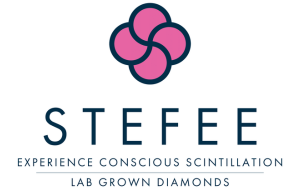What is the Cut of a Lab-Grown Diamond?
A lab diamond cut refers to the arrangement of a diamond's facets and the quality of its proportions, symmetry, and polish. According to diamond experts, the cut is the most essential characteristic to consider when buying a lab-grown diamond.
A Breakdown of the Key Aspects of a Lab-Grown Diamond Cut
- Facet: A facet is a flat, polished surface on a lab-grown diamond. Lab professionals or skilled artisans meticulously and precisely cut and arrange these facets to maximise the diamond's ability to reflect and refract light. The cutting process upgrades the diamond's brilliance, fire, and scintillation, which is crucial for influencing the diamond's overall visual appeal and light performance.
- Proportion: An ideal balance of dimensions and angles within a diamond's facet to augment light performance.
- Symmetry: A precise alignment of a diamond's facets.
- Polish: The smoothness and quality of a diamond's surface.
When all these factors - the facets, proportion, symmetry, and polish are optimised, they work together to enhance the gemstone's brilliance, beauty, reflection, and sparkle. This comprehensive understanding of the diamond's quality will help you make an informed decision when purchasing a lab-cut diamond.
Anatomy of a Lab-Cut Diamond
There are 8 types of facets that make up a diamond cut. Each is aligned with specific calculations and accuracy. As you look at a lab-grown diamond India from above, the table might seem the most important part of the gemstone. However, every facet plays a significant role in improving the captivating charm of the diamond, giving it the best cut.
The parts of a diamond cut are:
- Table: A large, flat facet on the top of the diamond through which light enters.
- Crown: The crown is the upper portion of the diamond above the girdle. It consists of several important facets, such as:
- Table Facet: It is the biggest facet on top of the diamond.
- Star Facets: These small triangular facets extending from the table to the upper girdle.
- Bezel Facets: These are kite-shaped facets that are located between the star facets and the girdle.
- Girdle: The girdle is a narrow band encircling the gemstone from the middle. It separates the crown from the pavilion.
- Pavilion: The pavilion is the lowest portion of the diamond. It includes:
- Main Pavillion Facets: These are larger facets that extend from the girdle to the culet.
- Lower Pavillion Facets: These are facets between the main pavilion and the girdle.
- Culet: Culet is a tiny or pointed facet at the bottom tip of the diamond.
- Depth: It signifies the total height of the diamond from the table to the culet.
- Crown Height: It is the vertical distance from the girdle to the table.
- Pavilion Depth: It is the vertical distance from the girdle to the culet.
Optical Qualities of a Lab-Grown Diamond's Sparkle
In order to completely understand how a diamond's cut works, it is necessary to know how the light performs inside the gemstone. The fundamental elements related to a diamond's shine can be categorised in the following:
-
Fire: Fire in diamonds refers to the dispersion of light into spectral colours, creating a rainbow effect. Such a wonder occurs when light enters the diamond and is separated into various segmented colours due to the diamond's ability to bend light at different angles.
-
Brilliance: Brilliance is the brightness a diamond emits as a reflection of natural light. It is determined by the lab diamond's cut and, especially, how well it interacts with light to reflect it through the top.
- Scintillation: Scintillation refers to the pattern of light, the dark areas and the sparkle or flashes of light that are visible when a diamond is moved. The interaction of light with facets creates bright and dark regions within the diamond.
Why is Lab Diamond Cut Important?
The cut of the diamond is important as it directly impacts how much it sparkles and shines, making it more beautiful. The diamond cut can even make the stone appear larger.
Lab Diamond Cut vs Shape
A lab diamond cut refers to the craftsmanship and quality of the way the diamond is faceted and polished. It also refers to the stone's ability to interact with light and emit radiance.
Conversely, the lab diamond shape refers to the diamond's final outline or external form. Some common shapes are princess (square), emerald, pear, heart, and oval-cut lab-grown diamonds.
How are Lab-Diamonds Cut?
Stefee Jewels has mastered the art of diamond cutting over the years. Our lab diamonds are cut at our state-of-the-art facility using the latest technologies under the expert supervision of our experienced team.
How is a Diamond Cut Graded?
GIA (Gemological Institute of America) and IGI (International Gemological Institute) are reputed laboratories that grade lab-grown diamonds. Stefee Jewels is a GIA-certified company.
A lab-cut diamond is typically graded on a scale from Excellent/Ideal to Poor. The criteria for evaluating a cut are the diamond's proportion, symmetry, and polish.
How to Choose the Best Lab-Cut Diamond?
Choosing a cut depends on your tastes, preferences and occasion. The following points can help you decide:
-
The round and oval-cut lab-grown diamonds are the most sought-after and most expensive.
- For fancy and unique shapes, shoppers usually opt for a heart or emerald-cut lab-grown diamond.
- The asscher and marquise diamond cuts are the rarest out of all shapes.
